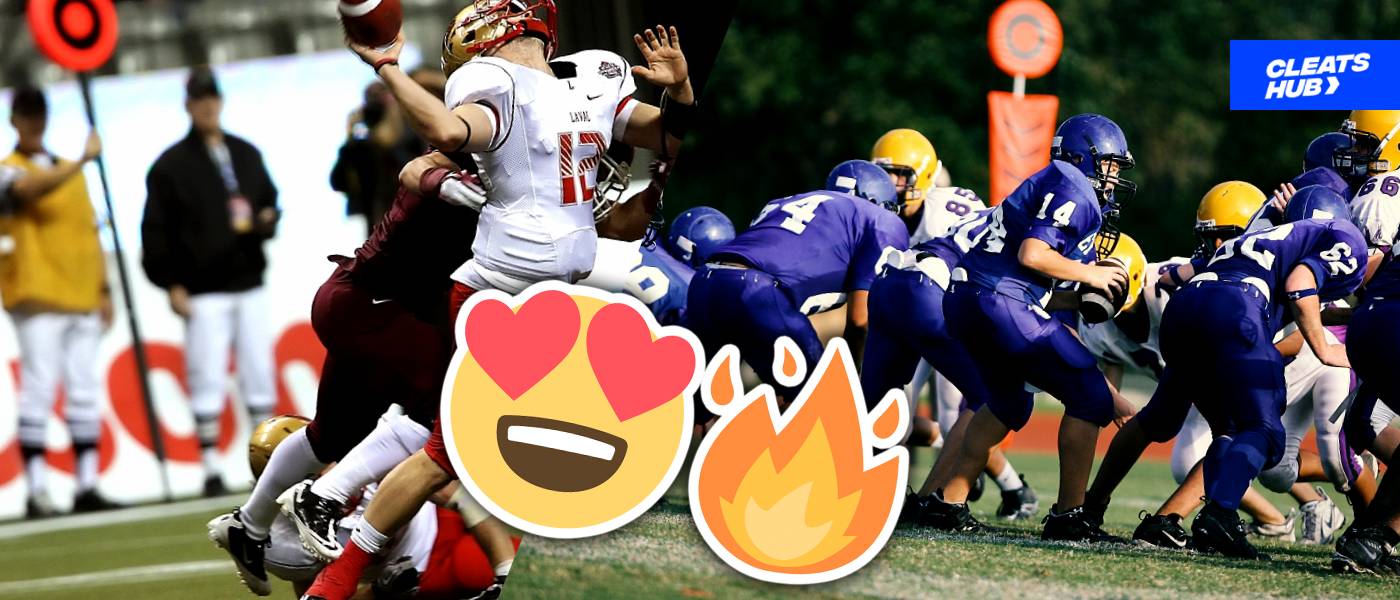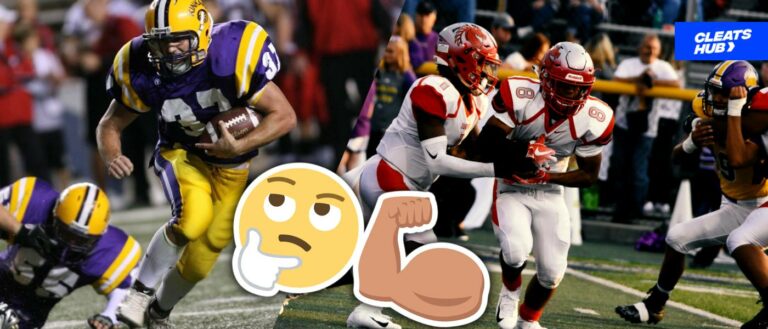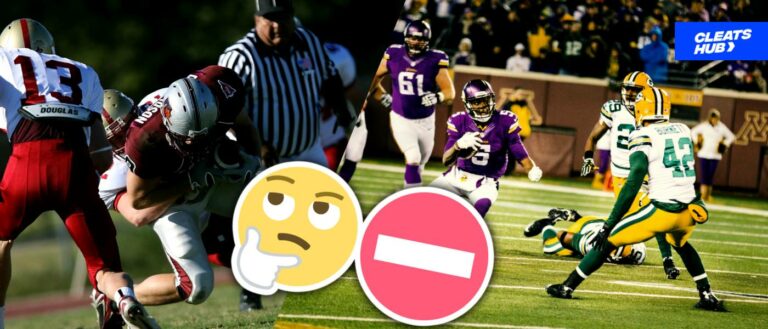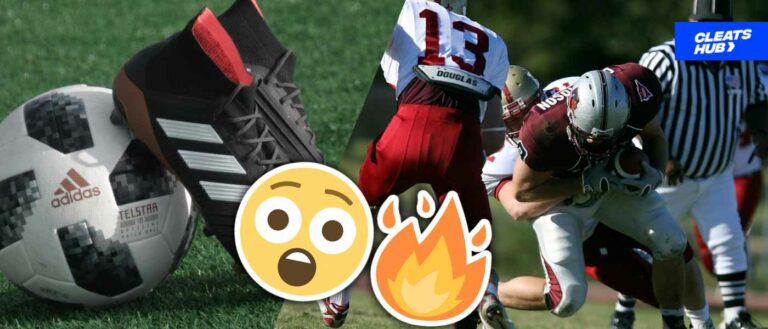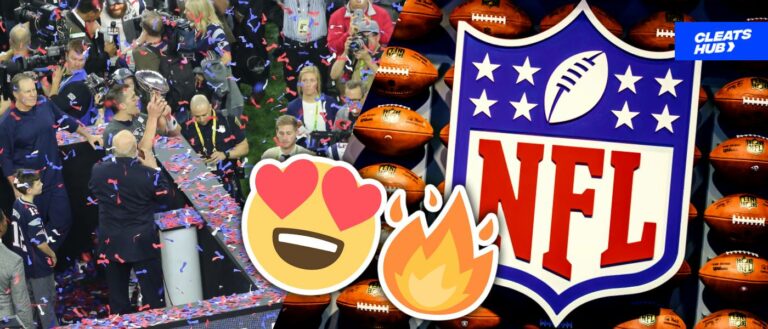What Is A Linebacker? (NFL Linebacker Positions)
Defensive play in football comprises a number of units that work together in individual sections of the field to ensure that the offensive play of the opposing team is altered. One of the positions that is involved in a team’s defensive strategy is linebacker.
They are the second line of defense just after the defensive line, and they put in a lot of work to ensure their position is not compromised. Here is all you need to know about linebackers in the NFL.
About Linebackers IN American Football
The linebacker in football is the defensive position just behind the defensive line that serves as the second line of defense if the offense of the opposing team makes it past the defensive line.
When it comes to structure and build, linebackers are players with a very good physique; however, they are also agile and athletic. Replicating all the responsibilities of the defensive line – stopping the run and pass — they also shoulder some personal roles.
These roles involve acting as the captain of the defensive squad and deciphering the opposing team’s offensive play.
How Many Linebackers Are On A Football Team?
The number of linebackers in a football team differs based on the type of playing strategy the team decides to use. Nevertheless, there are usually three to four linebackers on the field at a time.
These can also be classified into three types of linebackers, depending on the role they play. We have Sam, Will and Mike. These names are given to linebackers so they know the positions they play.
- Sam:
Sam is a type of linebacker who lines up on the strong side of the offensive line. He is sometimes referred to as the most balanced linebacker because of his ability to be very good in pass coverage and run coverage. - Will:
Just like Sam, Will is the name given to the linebacker who lines up on the weak side of the offensive line. He is often the playmaking linebacker who is shielded by Sam and Mike. The reason for this is so that he will be able to counter passes, disrupt the offense, and have room to tackle. - Mike:
Lastly, we have Mike. He is the linebacker who plays the middle role between acting on the strong side (Sam) and working on the weak side (Will). He is also called the quarterback of the defense. He is tasked with relaying and controlling the defensive play to Sam and Will from the sidelines (coach). This is part of the reason why he is the only player allowed to use a headset inside his helmet for communication.
Why Are They Called Linebackers?
When playing football, the role of the linebacker is, in its basic form, to provide backup to the defensive line, hence the name. Also, since they are positioned just behind the defensive line on the field, gives more credibility to the reason for their name.
Role of A Linebacker
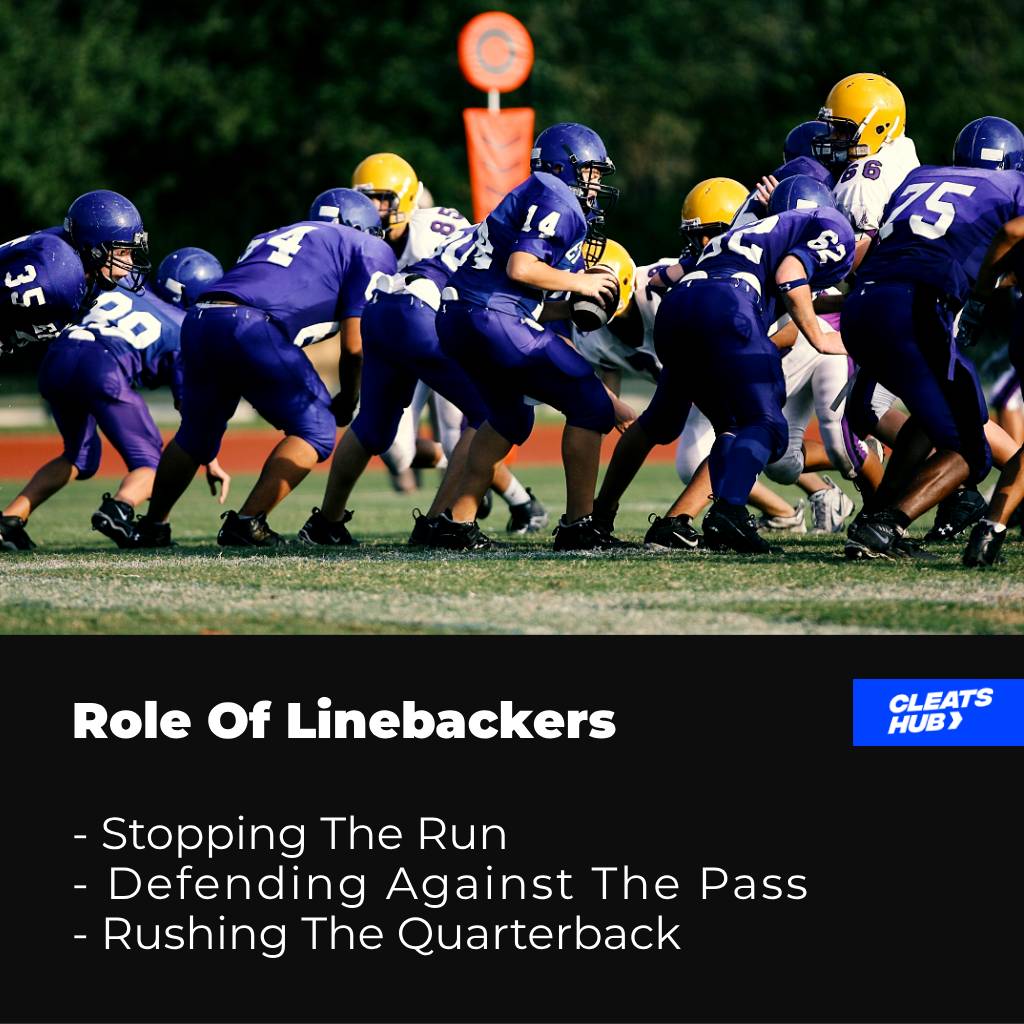
Linebackers perform a variety of roles on the field, which makes them crucial playmakers for the defense.
Also, they are essential in stopping the run, guarding against the pass, and sabotaging the attacking strategy of the opposition.
1. Stopping the Run
One of the primary responsibilities of linebackers is to stop the run game. They must read the offensive play, remove blocks, and prevent running backs from gaining ground.
Moreover, strength, agility, and the ability to spot plays quickly are all required. Linebackers must close gaps, maintain proper run fits, and pursue the ball carrier relentlessly.
2. Defending Against the Pass
Linebackers are also in charge of intercepting passes. Entering coverage and interfering with tight end, running back, and even wide receiver routes is part of this.
Linebackers must also have great lateral mobility, agility, and football intelligence in order to anticipate and respond to quarterback throws.
3. Rushing the Quarterback
Linebackers are known for rushing the opposing team’s quarterback, forcing them to make mistakes, and then tackling them.
Furthermore, these pass-rushing linebackers, often known as edge rushers, use a variety of strategies to get past offensive linemen. This gradually breaks the quarterback’s cadence.
Fast rushes, bull rushes, and spin maneuvers are some of the very efficient methods used.
Types of Linebackers
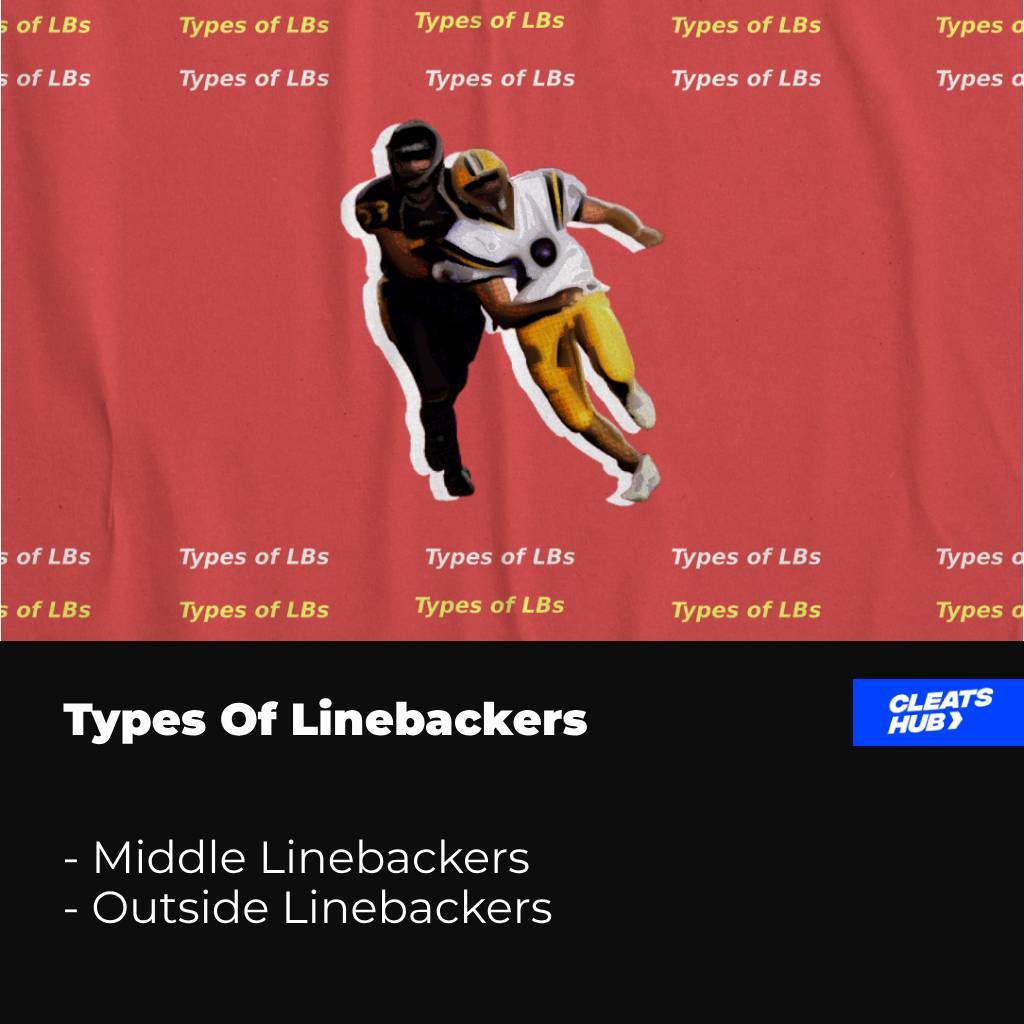
1. Middle Linebacker (MLB)
The middle linebacker, commonly known as the “Mike” linebacker, is in the heart of the linebacker corps. The MLB, who is positioned in the formation’s center, is responsible for organizing the defense, calling plays, and evaluating the offense’s pre-snap alignment.
Because of their leadership and game-reading ability, they are critical for directing the defensive strategy.
2. Outside Linebackers (OLB)
A common defensive formation includes two outside linebackers: a strong-side linebacker and a weak-side linebacker (WLB). The WLB is on the opposite side of the tight end, whereas the SLB is on the other side.
The unique combination of skills possessed by outside linebackers enables them to apply pressure to the quarterback, establish the edge against the run, and descend into coverage against receivers or tight ends.
Skills of Linebackers

To thrive in their position, linebackers need a special set of physical qualities and football abilities. Linebackers must possess the following abilities and traits to succeed on the field.
1. Physical Qualities
Linebackers must have a good combination of size, speed, strength, and agility to be successful. They must be big and strong to engage offensive linemen, shed blocks, and take down tough running backs.
Second, speed and agility are required for covering receivers, pursuing ball carriers, and effectively rushing the quarterback.
2. Football Intelligence
Linebackers are frequently referred to as the “quarterbacks of the defense” since they are responsible for assessing and responding to opposing offenses.
They must also have excellent football intelligence, be able to comprehend play concepts, understand attacking formations, and make split-second decisions.
Furthermore, because of their mental agility, linebackers can position themselves efficiently on the field by anticipating the opponent’s actions.
3. Tackling Technique
Linebackers, who are the primary tacklers, must have effective tackling techniques in order to knock down ball carriers. Tackling with appropriate form decreases the number of yards gained by the offense and prevents big plays.
Linebackers must also be capable of tackling through the tackle, wrapping up the ball carrier, and delivering powerful punches while maintaining control.
4. Coverage Expertise
Because of their importance in pass defense, linebackers must be great at coverage. They must be able to match up against quick and nimble receivers or tight ends, as well as backpedal and change directions quickly.
Furthermore, great coverage skills include the ability to anticipate routes, read the quarterback’s eyes, and impede passing lanes.
5. Communication and Cohesion
A strong linebacker unit works as a cohesive, coordinated unit. They communicate effectively, exchange data, make changes, and ensure that everyone is on the same page.
Second, because of efficient communication, they can anticipate plays, react quickly, and maintain the proper position on the field.
Techniques Used by a Linebacker Unit
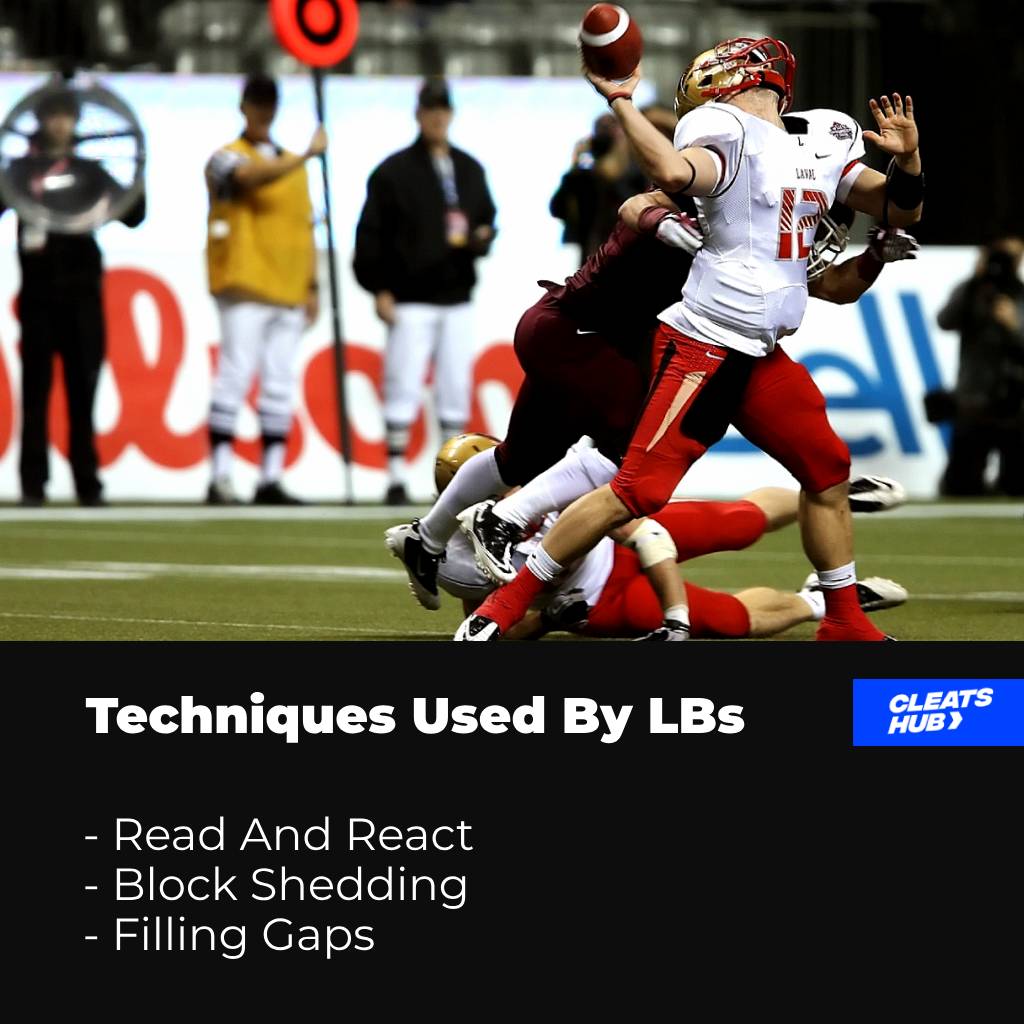
- Read and React:
Linebackers need to be able to understand what the offense is doing and react in the right way. To figure out where the play is going, they look at the formation, the most important attackers, and the opening plays. With this strategy, linebackers can predict the play, close gaps, and chase the ball carrier. - Block Shedding:
When collaborating with offensive linemen and other blocks to make plays, linebackers must employ evasive methods. The arm-over, swim move, rip move, and spin move are just a few of the tricks they use to get to the ball carrier. - Filling Gaps:
Linebackers have to fill certain gaps in the defensive front so that running backs can’t find holes. They need to know how the offensive line is going to block for them, find the hole quickly, and hit it hard. If you fill the gaps well, running backs won’t have much room to move. - Tackling:
Tackling is a very important skill for linebackers. They use different approaches depending on the situation. These include form tackling, in which the linebacker surrounds the ball carrier, pushes through the tackle, and safely puts the ball carrier on the ground. Depending on the circumstance, other methods may be used, such as the “bull” or “thud” tackle. - Blitzing:
Linebackers are frequently employed as blitzes to pressure the quarterback. They employ a variety of pass-rushing methods to beat offensive linemen and destabilize the pocket. To get the quarterback sacked, these strategies include chaos-creating speed rushes, bull rushes, spin movements, and swim moves, among others.
Top Linebackers Units in NFL History
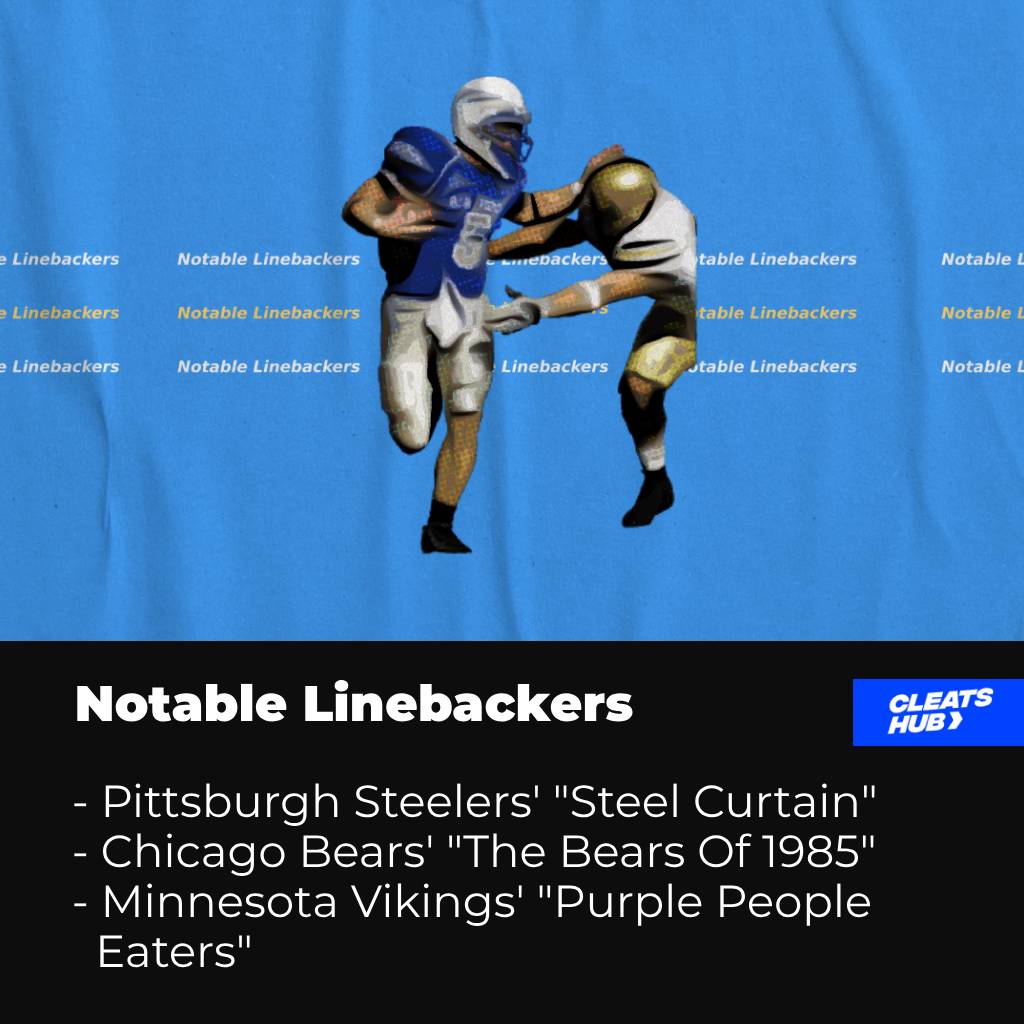
The NFL has had a long and illustrious history, and several clubs have had outstanding linebacker groups.
However, the following have demonstrated unmatched talent, domination, and influence on the game.
1. Steelers of Pittsburgh, the Steel Curtain
The “Steel Curtain” linebacker squad assembled by the Pittsburgh Steelers in the 1970s, known for their legendary defense, is regarded as one of the best in NFL history.
Second, the famous Jack Lambert commanded the Steel Curtain linebackers, who included Jack Ham, Andy Russell, and Robin Cole.
Furthermore, this team led the Steelers to four Super Bowl victories in the 1970s by demonstrating perseverance, adaptability, and unequaled insight.
2. The Bears of 1985: Chicago Bears
The Chicago Bears’ fierce defense in 1985 revolutionized the game. The three linebackers at the heart of this strong bunch were Mike Singletary, Otis Wilson, and Wilber Marshall.
Second, Hall of Famer Singletary dominated the middle with his vigor and acumen.bFurthermore, Wilson and Marshall, two superb athletes, demolished their opponents’ offenses with their speed and ability to make plays.
The linebackers for the Bears in 1985 set the standard for the whole defense by guiding the team to a Super Bowl victory and establishing themselves as one of the most dominant groups in NFL history.
3. The Purple People Eaters: Minnesota Vikings
In the late 1960s and early 1970s, the Minnesota Vikings’ “Purple People Eaters” linebacker trio terrified their opponents. The linebackers included Wally Hilgenberg and Roy Winston, who were headed by defensive stalwart and Hall of Famer Carl Eller.
This legendary squad, known for its tenacity and exceptional run-stopping abilities, was the foundation of a Vikings defense that was consistently ranked among the best in the league.
Furthermore, the Purple People Eaters’ linebackers were critical to the team’s success, which resulted in a Super Bowl IV appearance.
Conclusion
Linebackers are dynamic playmakers who have an influence on the game at every level thanks to their ability to stop the run, defend against the pass, and pressure the passer.
Secondly, they are essential anchors in any defensive strategy because of their special combination of skills. Moreover, linebackers must continue to adapt and hone their skills as the game changes to stop the offensive plans that are always being developed.

